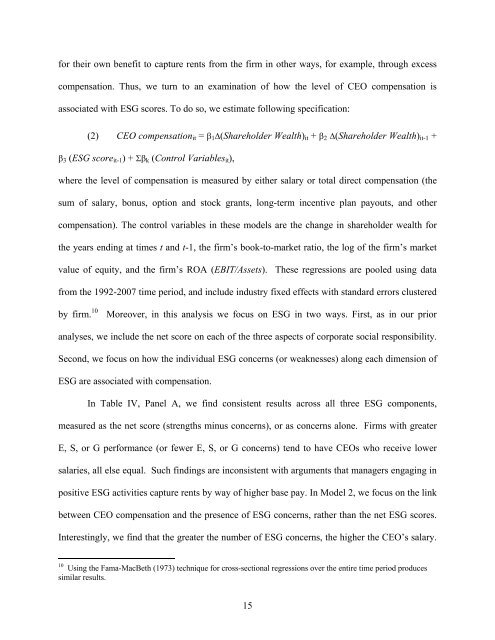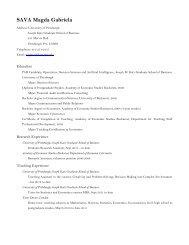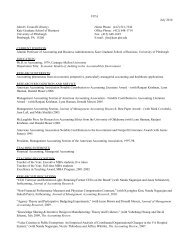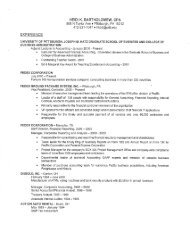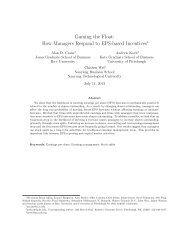Stuart L. Gillan, Jay C. Hartzell, Andrew Koch, and ... - Pitt Business
Stuart L. Gillan, Jay C. Hartzell, Andrew Koch, and ... - Pitt Business
Stuart L. Gillan, Jay C. Hartzell, Andrew Koch, and ... - Pitt Business
You also want an ePaper? Increase the reach of your titles
YUMPU automatically turns print PDFs into web optimized ePapers that Google loves.
for their own benefit to capture rents from the firm in other ways, for example, through excess<br />
compensation. Thus, we turn to an examination of how the level of CEO compensation is<br />
associated with ESG scores. To do so, we estimate following specification:<br />
(2) CEO compensationit = 1(Shareholder Wealth)it + 2 (Shareholder Wealth)it-1 +<br />
3 (ESG scoreit-1) + k (Control Variablesit),<br />
where the level of compensation is measured by either salary or total direct compensation (the<br />
sum of salary, bonus, option <strong>and</strong> stock grants, long-term incentive plan payouts, <strong>and</strong> other<br />
compensation). The control variables in these models are the change in shareholder wealth for<br />
the years ending at times t <strong>and</strong> t-1, the firm’s book-to-market ratio, the log of the firm’s market<br />
value of equity, <strong>and</strong> the firm’s ROA (EBIT/Assets). These regressions are pooled using data<br />
from the 1992-2007 time period, <strong>and</strong> include industry fixed effects with st<strong>and</strong>ard errors clustered<br />
by firm. 10 Moreover, in this analysis we focus on ESG in two ways. First, as in our prior<br />
analyses, we include the net score on each of the three aspects of corporate social responsibility.<br />
Second, we focus on how the individual ESG concerns (or weaknesses) along each dimension of<br />
ESG are associated with compensation.<br />
In Table IV, Panel A, we find consistent results across all three ESG components,<br />
measured as the net score (strengths minus concerns), or as concerns alone. Firms with greater<br />
E, S, or G performance (or fewer E, S, or G concerns) tend to have CEOs who receive lower<br />
salaries, all else equal. Such findings are inconsistent with arguments that managers engaging in<br />
positive ESG activities capture rents by way of higher base pay. In Model 2, we focus on the link<br />
between CEO compensation <strong>and</strong> the presence of ESG concerns, rather than the net ESG scores.<br />
Interestingly, we find that the greater the number of ESG concerns, the higher the CEO’s salary.<br />
10<br />
Using the Fama-MacBeth (1973) technique for cross-sectional regressions over the entire time period produces<br />
similar results.<br />
15


